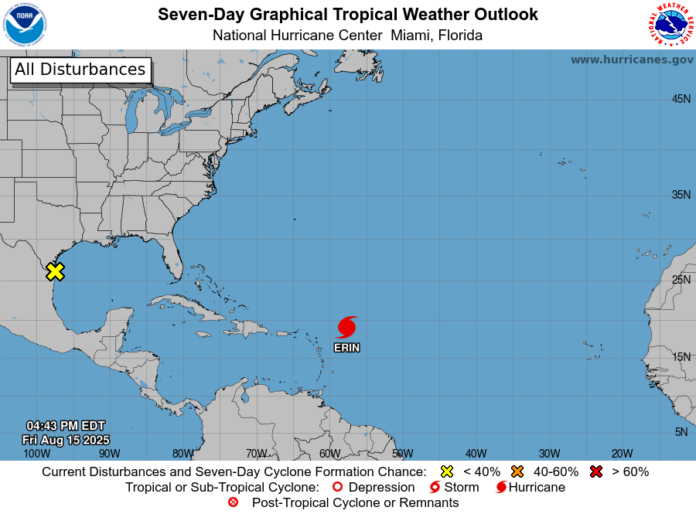Hurricane Erin is expected to intensify rapidly as it moves west-northwest across the Atlantic, with forecasters warning it could reach major hurricane strength over the weekend.
At 17:00 AST (21:00 UTC) on Friday, the US National Hurricane Center (NHC) said Erin was located about 365 miles (585 km) east of the northern Leeward Islands, with maximum sustained winds of 75 mph (120 km/h). The storm is moving at 17 mph (28 km/h).
On its current track, the hurricane’s centre is forecast to pass near or just north of the northern Leeward Islands, the Virgin Islands and Puerto Rico between Saturday and Sunday.
A tropical storm watch remains in effect for Anguilla, Barbuda, St Martin, St Barthelemy, Saba, St Eustatius and Sint Maarten. Tropical storm conditions could reach these areas by early Saturday.
The NHC says outer rain bands could bring 2–4 inches (5–10 cm) of rain to the northern Leewards, Virgin Islands and Puerto Rico, with isolated areas receiving up to 6 inches (15 cm). This raises the risk of flash flooding, landslides and mudslides.
Swells generated by Erin are expected to create hazardous surf and life-threatening rip currents in the region from Saturday, spreading across the western Atlantic next week.
NOAA and Air Force Reserve Hurricane Hunter aircraft are scheduled to investigate the storm later on Friday. Forecasters say steady to rapid strengthening is expected in the coming days.
SUMMARY OF WATCHES AND WARNINGS IN EFFECT:
A Tropical Storm Watch is in effect for…
- Anguilla and Barbuda
- St. Martin and St. Barthelemy
- Saba and St. Eustatius
- Sint Maarten
A Tropical Storm Watch means that tropical storm conditions are possible within the watch area, generally within 48 hours.
Interests elsewhere in the northern Leeward Islands, Virgin Islands, and Puerto Rico, as well as in the Turks and Caicos and the southeastern Bahamas should monitor the progress of Erin.
For storm information specific to your area, please monitor products issued by your national meteorological service.
DISCUSSION AND OUTLOOK
At 500 PM AST (2100 UTC), the center of Hurricane Erin was located near latitude 18.9 North, longitude 57.6 West. Erin is moving toward the west-northwest near 17 mph (28 km/h). This motion is expected to continue through the weekend with some decrease in forward speed. On the forecast track, the center of Erin is likely to move just north of the northern Leeward Islands, the Virgin Islands, and Puerto Rico over the weekend.
Maximum sustained winds are near 75 mph (120 km/h) with higher gusts. Steady to rapid strengthening is expected during the next two to three days, and Erin is forecast to become a major hurricane during the weekend. NOAA and Air Force Reserve Hurricane Hunter aircraft are scheduled to investigate Erin this evening.
Hurricane-force winds extend outward up to 25 miles (35 km) from the center and tropical-storm-force winds extend outward up to 115 miles (185 km) mainly to the north of the center.
The estimated minimum central pressure is 993 mb (29.33 inches).
HAZARDS AFFECTING LAND
Key messages for Erin can be found in the Tropical Cyclone Discussion under AWIPS header MIATCDAT5 and WMO header WTNT45 KNHC.
RAINFALL: The outer bands of Erin are expected to produce areas of heavy rainfall tonight into Sunday across the northern Leeward Islands, the Virgin Islands, and Puerto Rico. Rainfall totals of 2 to 4 inches, with isolated totals of 6 inches, are expected. This rainfall may lead to isolated and locally considerable flash and urban flooding, along with landslides or mudslides.
For a complete depiction of forecast rainfall and flash flooding associated with Erin, please see the National Weather Service Storm Total Rainfall Graphic, available at hurricanes.gov/graphics_at5.shtml?rainqpf
WIND: Tropical storm conditions are possible within the watch area by early Saturday.
SURF: Swells generated by Erin will begin affecting portions of the northern Leeward Islands, the Virgin Islands and Puerto Rico by this weekend, and will likely spread to the western Atlantic next week. These swells are likely to cause life-threatening surf and rip current conditions. Please consult products from your local weather forecast office.
A depiction of rip current risk for the United States can be found at: hurricanes.gov/graphics_at5.shtml?ripCurrents
NEXT ADVISORY
Next intermediate advisory at 800 PM AST.
Next complete advisory at 1100 PM AST.


